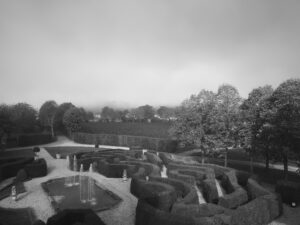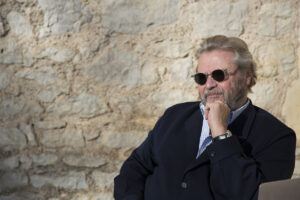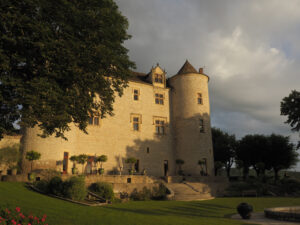That dreadful anxiety started to rear its ugly head as the European woman got closer to her destination but seeing the various shades of green that went on forever, only momentarily broken up by the mountain peaks, gave her the courage to continue. Her heart stopped! “What was that sound?!” she muttered to herself. Then her mind began to race. Was it something falling out of the numerous trees? What fell? Did something step on a twig? What was that something? An animal? Or a person hunting? But then, all of a sudden, she could see in the distance some indigenous women with sticks piercing their cheeks and lips. “I need to stop breathing so loud,” the European lady said inside her head as she tried to slowly inhale and exhale as her heart seemed to want to burst within her chest. “Should I be here? Am I doing more harm than good?” But then all doubts subsided as she became engrossed with these pure beings untouched by greed and corruption, although being unaffected by the outside world was no longer going to be the case.
Many years after that moment, Alain Dominique Perrin, the man who is known for saving Cartier, the watchmaker and jeweler, honored this woman, artist and activist Claudia Andujar, for her over 50 years of service in protecting the indigenous people, the Yanomami, in the rainforests and mountains of northern Brazil and Venezuela.
The Fondation Cartier pour l’art contemporain, in collaboration with The Shed in New York City, is currently showing the largest exhibition of Claudia Andujar’s photographs showing the Yanomami tribes, one of Brazil’s largest indigenous groups, which is remarkable considering that contact with outsiders had been forbidden for centuries especially considering that slave-hunters wiped out other indigenous societies during the early 1600s to the early 1700s.
At the beginning of February, Alain Dominique Perrin was there at the opening of this exhibition on behalf of Cartier to pay homage to a woman who based her life on preserving a way of life for peaceful people who lived in complete harmony with their surroundings. But he was also in New York City for his own personal passion, to talk about his wines from the 15th-century Château Lagrézette estate, in South West France, which took him over 20 years to restore.
Outsiders: To Trust Or Not To Trust
At the tender age of 24, Claudia Andujar moved from Switzerland to Brazil where she picked up a camera for the first time. Her first language was French so she found it easier to communicate with others through her photos. Her pictures were published in top international magazines such as Life, but in the early 1970s, at around 40, she traveled to Yanomami territory to observe the Yanomami people. She innately knew that she would be a mistrusted presence so she decided to make the shocking decision to live there for a year without taking any photographs as she wanted to get to know the Yanomami people and build trust among them.
Claudia’s journey seemed like a crazy one with the potential for so much peril and the unbelievable journey of Alain Dominique Perrin, restoring a massive château with its long-neglected vineyards, seemed equally crazy to those in the luxury world who knew him. The multi-generational locals in the tiny town of Caillac, with only around 600 residences, within the wine area of Cahors, where Alain’s beloved Château Lagrézette is located, looked at him with the same distrust Claudia faced with the Yanomani people. Alain was “the establishment,” he noted, and just like other wine regions in France, such as Burgundy, outsiders who buy wine estates force property values up, significantly increasing taxes, making it impossible for future generations to take over family businesses. The people from the cities were seen as ruining the lives of those who were people of the land in the country.
Yet just like Claudia, Alain’s devotion to restoring, and not destroying, was unwavering, as the painful restoration of Château Lagrézette included every little nook as well ancient cups and such within the château, not to mention bringing the soil back to life. Yet Claudia’s role was more about preserving what lived in those rainforests – Mother Nature would handle the restoration.
The Rest of the World taking Notice
As Claudia built trust among the Yanomani people, she photographed over two decades of a dictatorship opening up the Amazon to mining and the aggressive deforestation of the rainforests that would bring multiple diseases, such as a measles epidemic that killed many of the Yanomami people. Her photos showed the world of such atrocities so the military banned her from visiting the Yanomami people. A Yanomani leader and shaman sought out Claudia to see why she was causing the government so much fear and once they met, she told him that her people were killed with many others by a brutal government, and so, the shaman knew that he could trust her. Her family were Jews who were sent to concentration camps in Poland and Germany, none of whom survived, so she carried a crippling amount of guilt because she couldn’t save them, even though she was only a child at the time. If she couldn’t save her family, she would try to save the Yanomani.
As Claudia was first establishing her relationship with the Yanomami people in the early 1970s, Cartier found itself in bad times with the Cartier family no longer involved in the business. Alain Dominique Perrin was considered a young rising star at Cartier and within a matter of a few years, was leading a strategy based on the finest materials and most skilled artisans to make Cartier one of the most highly prized jewelers in the world. He also declared war on counterfeit luxury goods on the market through the media which included setting fake merchandise ablaze.
When Alain’s name is mentioned among certain circles in France, one might hear such phrases as, “he is a God,” as he was one of the leading players that brought prestige back to Cartier, creating jobs and revenue for France as well as being a point of pride for the French people. And Alain created Fondation Cartier, the same entity honoring Claudia Andujar’s life work with exhibitions of her photos worldwide.
But his Cartier legacy is not something that he can pass down to his five children and so he took on another herculean task – the restoration of Château Lagrézette, with vineyards that have documentation, according to Alain, that date back to the 1500s. Like Cartier, throughout everything with Château Lagrézette, he tenaciously wouldn’t accept anything but the best, regarding the castle, the land and the wines, as anything less is not in his DNA.
“When I started, I had a lot of enemies, and now, I have a lot of friends,” Alain said when talking about his relationships with the locals of Caillac. Just like Claudia Andujar, her mission was to protect the indigenous and their way of life with the privilege and talent she brought with her and the same can be said for Alain. It may seem impossible to get notoriety and success in Caillac, France, while also protecting the local families and their legacies – but if it can be done, there is no better person than the man who brought Cartier from the brink of despair to one of the most prestigious names in the world.
***Link to original Forbes article: https://www.forbes.com/sites/cathrinetodd/2023/03/09/the-man-who-saved-cartier-is-now-saving-an-ancient-wine-estate/
Château Lagrézette is located in the tiny town of Caillac in the Lot department in South West France, and all of the wines below, except the rosé, may use the Cahors wine appellation.
2021 Roseberry, Rosé: 100% Malbec from limestone and clay soils. Lots of stony minerality with white strawberry and a hint of raspberry flavors.
2018 Seigneur de Grezette: 85% Malbec and 15% Merlot from plots with silt-clay and gravel soils with 20-year-old vines. Broken rocks, blackcurrants, fresh sage and black raspberry with fine tannins and a spicy finish.
2019 Chevalier du Château Lagrézette: 100% Malbec from the third terrace on the estate in Kimmeridgian limestone from 30-year-old vines. Tobacco leaf and tree bark on the nose and juicy cassis on the palate with a good weight with an overall elegant shape.
2016 Château Lagrézette: 100% Malbec from the third terrace of the property with limestone and clay vineyards from 35-year-old vines. A dark and deliciously decadent wine balanced by dried herbs and earthy notes with a silky texture.
2015 Château Lagrézette: 100% Malbec from the third terrace of the property with limestone and clay vineyards from 35-year-old vines. Vibrant with minty aromas and hints of fresh blackberries with lots of complexity with notes of leather, tar and lots of structure, giving it lift on the finish.
2018 Paragon: 100% Malbec from an exceptional vineyard known as Landiech with soils made up of gravel and clay from very low-yielding grapes. Charming nose of violets and blueberry fruit with layers of delectable flavors such as cinnamon roll and licorice with finely-laced tannins with an overall finesse.
2015 Le Pigeonnier: 100% Malbec from an outstanding isolated section of a vineyard that produces powerful fruit from 35-year-old vines. Opaque color with dark, brooding fruit that draws one into the glass with black cherry cobbler, smoldering cigar and cedar aromas along the muscularly shaped body with a very long and flavorful finish.
















